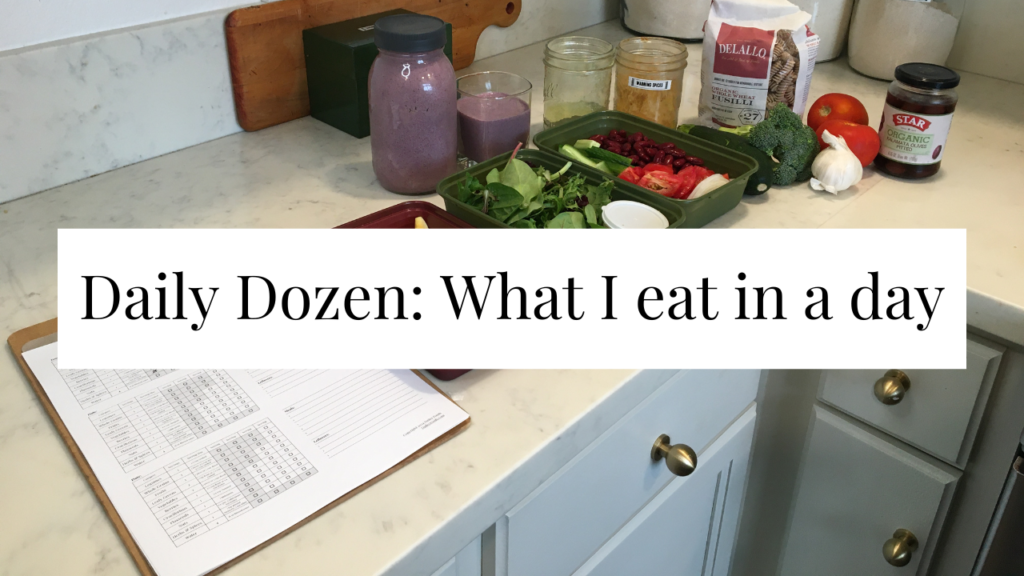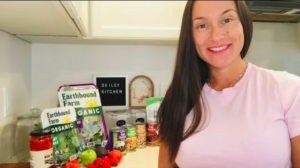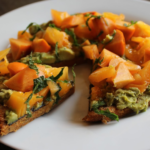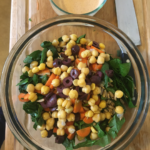
Ready to track your food intake? Here’s a simple, daily food checklist of what to eat every day. Store this food checklist in your recipe binder for easy access during meal planning.
What to eat every day
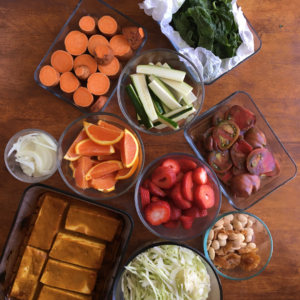
The below listed daily food recommendations are based on The Power Plate from Physicians Committee for Responsible Medicine as well as the Daily Dozen diet recommendations from NutritionFacts.org. Both organizations are excellent resources for evidence-based nutrition information.
The Power Plate and Daily Dozen recommend a whole food, plant-based diet for permanent weight loss, diet-related disease prevention and survival, as well as optimum bodily function. The below food checklist is comprised of dietary recommendations from both organizations made simple and straight forward.
What is the Daily Dozen?
Here’s a quick overview of what the Daily Dozen is and how to get started:
Daily Dozen checklist printable
I created a free printable which you can use to track and meal plan your Daily Dozen meals. Learn more and download this printable:
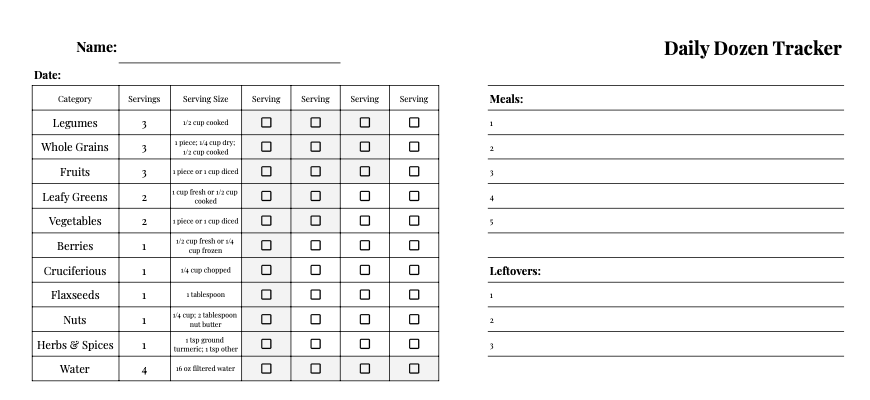
Daniel Fast Diet
Did you know the Old Testament in the Bible shares about a plant based diet in the book of Daniel?
Plan your meals around the Daily Dozen
Keeping track of your Daily Dozen food and water intake. It also helps you plan your meals, track your meals and leftovers.
Daily food checklist: Here’s what to eat every day

In summary, here’s what to eat each day based on the Daily Dozen dietary recommendations to maintain a healthy body:
- Legumes
- Whole Grains
- Berries
- Fruit
- Nuts
- Seeds
- Leafy Greens
- Cruciferous Vegetables
- Herbs and Spices
- Water
- Supplement with Vitamins B-12 and D-3, optional
For meal planning, ensure you’re getting your daily intake by planning around the above listed foods.
Meal planning is fun when you get to choose from a big list of foods and be creative with putting them together meals.
Consult your physician
Individual needs vary, please consult your physician prior to making any changes to your diet. Eat as many servings of each items listed below that feels comfortable with your own body. Exclude any foods that you are allergic to or that are undesirable to you. Based on basic nutrition research, the following foods are recommended as part of a healthy diet.
Daily Food Checklist

This daily food checklist follows a whole food, plant-based diet. I created it using the dietary recommendations of the “Daily Dozen” and the Physicians Committee for Responsible Medicine’s food plate.
- 3 servings Legumes (beans, lentils, peas)
- 3 servings Whole Grains
- 3 servings Fruit
- 2 servings Leafy Greens
- 2 servings Vegetables
- 1 serving Berries
- 1 serving Cruciferous Vegetables
- 1 serving Seeds
- 1 serving Nuts
- 1 serving Herbs & Spices
- 60 ounces Water/Beverages
Portion sizes
Here are some examples of approximate portion sizes for each food category:
- Legumes: 1/2 cup cooked legumes, tofu, tempeh; 1/4 cup legume dip
- Whole Grains: 1/4 cup dry grains; 1 piece bread, tortilla, or wrap
- Fruit: 1 medium piece; 1/4 cup dried
- Leafy Greens: 1 cup raw, 1/2 cup cooked
- Vegetables: 1 medium piece, 1/2 cup diced
- Berries: 1/2 cup fresh or 1/4 cup dried or frozen
- Cruciferous Vegetables: 1/2 cup chopped
- Seeds: 1 tablespoon, ground
- Nuts: 1/4 cup; 2 tablespoons nut butter
- Herbs & Spices: 1/4 tsp turmeric; any amount: garlic, ginger, basil, oregano, thyme, cayenne, and similar.
- Water/Beverage: About 8 cups.
Definitions of food categories

Here’s a brief explanation of some of the food categories listed above:
What is a legume?
A legume is a bean, lentil or pea. Servings can be whole legumes, tofu, tempeh, pureed soups, dips, spreads, legume flour.
What is a cruciferous vegetable?
Broccoli, cauliflower, and horseradish are examples of cruciferous vegetables.
What is a leafy green?
Kale, chard, collard greens, cabbage, spinach, beet greens, dandelion greens, and arugula are examples of leafy greens.
What is a vegetable?
A vegetable can be a root, tuber, or fruit vegetable such as carrots, tomatoes, beets, bell peppers, cucumber, zucchini, yellow squash, butternut squash, eggplant, and similar vegetables.
Diet information resources
Here’s a list of online places to learn more about what to eat everyday:
- Ultimate Guide to Daniel and Fasting Biblically in 2024
- Physicians Committee for Responsible Medicine
- Dr. Michael Gregor, MD
- Dr. Neal Barnard, MD
- Blue Zones
- Engine2Diet
- Jane Esselstyn, RD
- The Exam Room Podcast
Further reading:
